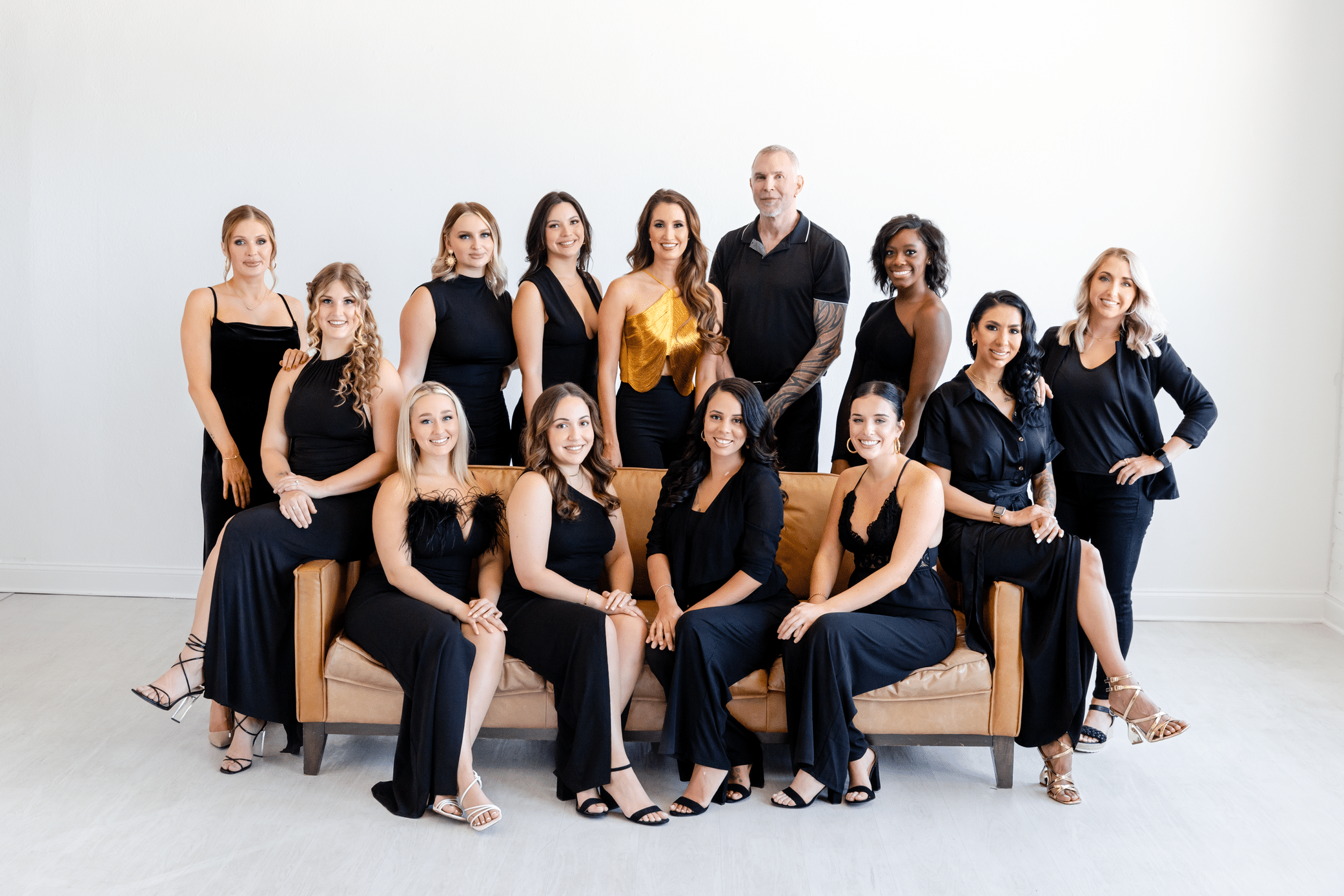(See also Eyelid, Browlift, Skin Care, Restylane®, BOTOX®)
Natural-Looking Facelift Surgery in Dallas
Almost every one of my consultations for facelift starts out telling me they are afraid of looking pulled tight and “weird”. While many in the public eye have beautiful results, the ones that really look odd are far more noticed and create a misperception about plastic surgery in general…that it’s always obvious and often looks a little funny. The irony is that most well performed plastic surgery is very natural and typically not overdone and so goes unnoticed.
Facelift Benefits
Friends just comment that you look nice. My goal with every facelift is to refresh; to reposition sagging tissues, tighten and redrape skin just to the point of the maximum correction without pulling or distorting facial features. I rarely inject fillers or fat at the time of the facelift. I’ve found that this too often results in an excessively “puffy” look and fillers can be very artistically and more accurately used to fine tune the result once the surgical swelling has settled. I’d like to describe my technique and philosophy regarding the facelift procedure to help reassure my patients that the style of facelift done here is typically not aggressive or overdone, but is thorough and comprehensive.
75% or more of my consultations say that their primary goal is to improve their neck and this affects how I approach and plan the operation. Every surgery is a little different because everyone’s anatomy and shape are unique, but I am not a fan of isolated necklifts. They are severly compromised in their power to really improve lax skin, resulting in a lot of disappointed patients. Thus the face and neck are treated as a unit and lifted together with variations to address individual anatomy and goals. The sequence of events is as follows.
How is a Facelift Performed?
After a thorough pre-surgical medical history and clearance (usually labwork and an EKG as a minimum) the procedure begins with your interview by one of our Board Certified MD anesthesiologists. I only use experienced MD anesthesiologists because it is my belief that it offers the ultimate in safety in the event of an unexpected reaction to the surgery or medications. All of my anesthesiologists are hospital based and take care of very critical patients on a regular basis. I trust each one of them with the utmost confidence.
Once asleep under a general anesthesia, the incision is placed based on the best choice for the individual, from the temple area curving in front of the ear and sometimes just inside the ear, under the earlobe then behind the ear. The position of these incisions is chosen based on the direction of lift that best suits each individual. The skin is precisely separated from the underlying fat to the middle of the cheek, across the jawline and in the neck from one side to the other. There is usually some unwanted fat under the chin which is removed with a tiny cannula by liposuction, smoothing the contour and freeing up the skin for redraping.
Once the skin is freed up completely, the deeper sagging tissues are repositioned. This is often referred to as “tightening the muscles” but more precisely involves elevating the fatty layer stuck to the muscles in an upward direction to their original, more youthful position. There are a number of methods to perform this step from simply placing stitches like a shoelace (called plication) to very extensively dissecting the fat and it’s underlying layer from the deeper structures with the theory that the lift his more aggressive and lounger lasting. Another method dissects just enough of the fatty layer to trim away the excess and secure it into position without the more radical and extended dissection. I have used all of these methods and find that the extremely aggressive and extensive dissection causes more of the tight or “puffy” looking results, which can look odd for a very long time. With plication alone I believe that there is a greater tendency to relapse since none of the stretched out saggy tissue is actually removed. Thus my preferred approach is the middle ground, freeing up the fatty layer over the muscle as much as necessary but no more, trimming away the excess and securing in a more youthful positions with 2 layers of sutures to ensure it stays in position. This is often called a strip SMASectomy. Interestingly, long term studies have looked at the results of each of these options and found them to be pretty equivalent in skilled hands, so it is difficult to criticize a surgeon for any of these choices. I do believe that the next step is the most critical however, and this is where the surgeons talent, precision and artistic eye come most into play and where I believe the imperfections occur that can lead to the “funny looking facelift”.
There is a fine line between redraping the skin too tightly or not quite enough. Typically I start with the neck, selecting the direction and amount of lift that maximally corrects the loose skin in this area. The position of the incision behing the ear is very important in getting the best lift for the neck, allowing the skin to slide back as far as necessary when properly positioned. The instrument used to judge this critical step is called a Pitanguy clamp and rests on the edge of the incision and holds the skin in position wherever the surgeon chooses. This critical step allows me to judge the result before marking and trimming away any skin. It also allow me to judge the circulation before committing to skin removal, a very important decision because excess tension causes compromised scar quality and can lead to strangulation of the tissues and healing problems. (These problems are greatly amplified in smokers, so I will not perform this surgery on a patient who smokes). The Pitanguy clamp allows me to get the maximum necklift while respecting the circulation. Any limitations in the lift are dictated by safety, something I discuss in advance as a non-negotiable with my patients.
Next, the cheek is lifted and redraped, again using the Pitanguy clamp to lift up towards the temple to get the maximum lift and adjust the ideal direction and position BEFORE any skin is trimmed away. If I see any distortion of the mouth,nose or corner of the eyes I release the clamp the amount necessary to get the maximum lift WITHOUT DISTORTION. While this may leave some lines or wrinkles that could have been stretched out, this style of facelift is the only kind that I would consider for myself or my family. I believe that any residual lines or folds that allow the avoidance of the stretched or pulled look are mandatory to accept in order to have a natural result. Once these 2 points of fixation are set (the temple area and behind the ear) the rest of the skin is gently redraped, precisely trimmed and set into position in front of the ear, below the earlobe and behind the ear with no tension, which allows the finest scars. The earlobe must not be used for any of the lift or it will be pulled downward (called a pixie ear deformity). Avoiding this is imperative to minimize the obvious visual tipoff of earlobe distortion. I always try to leave about 1mm of skin below the earlobe with my incision to better avoid distortion there.
Patient Testimonial
I am SO grateful I was referred to Dr. Rachel Walker and met her and her wonderful staff in Sept. 2020. Immediately, I felt very comfortable talking with Dr. Walker about having a “facelift” but I wanted to look natural and still look like “me” after the surgery. I was extremely impressed with Dr. Walkers expertise and methods in performing facelifts very different than other plastic surgeons I had consulted with before. I also met with the amazing Paul Kraft, a Medical / Aesthetic Laser Specialist that works with Dr. Walker and he throughly explained the lazer process and what results to expect. I am 60 yrs old, had never had Botox, had severe frown lines, numerous lines around my mouth and chin due to smoking years ago, also lines around my eyes with heavy eye lids and a sagging neck…I cannot express what a miraculous result I have had since my surgery 3 months ago. I look 10 yrs younger and my skin is beautiful. All my lines are completely gone! My eye lift was so remarkable that my vision improved and I had to get new glasses! I HIGHLY recommend Dr. Rachel Walker and Paul Kraft and their amazing knowledgeable staff. - Diane C. 12/30/20
Why are Suture Techniques so important for Facelifts?
Suturing must be meticulous with facelifting and I believe that a good plastic surgeon should take great pride in his suture technique, with virtually perfect skin alignment with extremely fine sutures. The sutures must ideally be removed in less than a week to avoid any suture marks in the skin. For this reason my facelift incisions are closed in 2 layers, one slowly dissolving layer beneath the skin to provide long term support and a second very fine layer on the skin to exactly approximate the edges, removed in 5 or 6 days at the latest.
Natural Results after Facelift Surgery
With these techniques and proper preparation, I have found that the vast majority of patients are extremely happy and most achieve their goal…a natural, rested, younger appearance that leaves others wondering how you stay looking so young… instead of what went wrong.
Scheduling a Consultation
To arrange a facelift consultation at The Plastic Surgery Center of Dallas, contact us today. We will be available to answer questions and discuss the details of the procedure.
Click to learn about Pain Management Options.




